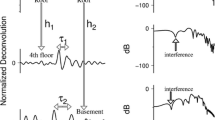Abstract
In preparation for a major earthquake in the Nankai Trough, the authors plan to introduce a real-time seismic diagnostic system for emergency management center building clusters in the Aichi prefecture eastern region in Japan. The system involves installing seismometers (three-axis accelerometers) in the buildings and storing observation records in a cloud-based internet system (the Cloud) in real time. Immediately after an earthquake, a simple diagnosis of the building’s residual seismic performance is performed using a lumped-mass model and emergency management officials are notified of the results by email. Also, a detailed analysis of the damaged condition using a three-dimensional frame model is performed for several hours after the event to try to assess the specific building parts that are damaged. This paper describes the proposed system and then presents the results of setting up the system and conducting trial operations in municipal government office buildings as a test case prior to actual system implementation.
















Similar content being viewed by others
References
Ueoka Y, Tanaka S, Abe I (2018) Effectiveness of rapid safety assessment of buildings after foreshock of the 2016 kumamoto earthquake using aerial photographs. J Soc Saf Sci ISSS Jpn 32:73–81 (in Japanese)
Architectural Institute of Japan (2018) Report on the damage investigation of the 2016 Kumamoto earthquakes (in Japanese)
Hori T (2017) Earthquake and Tsunami scenarios as basic information to prepare next Nankai Megathrust earthquakes. J Disaster Res 12(4):775–781
Kusunoki K, Tasai A, Teshigawara M (2012) Development of building monitoring system to evaluate residual seismic capacity after an earthquake. In: Proceedings of the 15th world conference on earthquake engineering, IAEE, Lisbon, Portugal, Sept. 2012
Morii T, Okada K, Shiraishi M, Sugimoto K, Terada T, Sato T (2017) Estimation of whole building seismic response using limited number of sensors. In: Proceedings of the 16th world conference on earthquake engineering, IAEE, Santiago, Chile, Jan. 2017
Kodera K, Nishitani A, Okihara Y (2018) Cubic spline interpolation based estimation of all story seismic responses with acceleration measurement at a limited number of floors. J Struct Constr Eng 83:527–535 (in Japanese)
Ruby. https://www.ruby-lang.org/en/. Accessed 26 Jan 2019
Saito T (2019) STERA_3D software. [Online]. http://www.rc.ace.tut.ac.jp/saito/software-e.html. Accessed 26 Jan 2019
Otsuki T, Saito T, Hayashi K (2017) Development of earthquake response monitoring system at Toyohashi city office. In: Summaries of technical papers of annual meeting—AIJ, pp 1125–1126 (in Japanese)
Building Center of Japan (2016) The building standard law of Japan
Hirata N, Kimura R (2018) The earthquake in Ōsaka-Fu Hokubu on 18 June 2018 and its ensuing disaster. J Disaster Res 13(4):813–816
Osaka earthquake (2019) https://en.wikipedia.org/wiki/2018_Osaka_earthquake. Accessed 26 Jan 2019
Japan Structural Consultants Association (2009) Research on improvement of earthquake resistance performance of building. In: Report of the building standard maintenance promotion program—MLIT (in Japanese)
Disaster Management Bureau. Report on the long-period ground motion by a huge earthquake along the Nankai Trough. Cabinet Office, Government of Japan
Acknowledgements
This paper reports a continuing research supported in part by the Tokyo Metropolitan Resilience Project of the National Research Institute for Earth Science and Disaster Resilience (NIED), the Japan Society for Promotion of Science (JSPS) under Grant number 16H03143 and the KDDI Federation number 30-2-1.
Author information
Authors and Affiliations
Corresponding author
Additional information
Publisher's Note
Springer Nature remains neutral with regard to jurisdictional claims in published maps and institutional affiliations.
Rights and permissions
About this article
Cite this article
Hayashi, K., Saito, T., Horioka, T. et al. Implementation of real-time seismic diagnostic system on emergency management center buildings: system introduction and operational status on municipal government office buildings. J Civil Struct Health Monit 9, 529–541 (2019). https://doi.org/10.1007/s13349-019-00349-4
Received:
Accepted:
Published:
Issue Date:
DOI: https://doi.org/10.1007/s13349-019-00349-4




